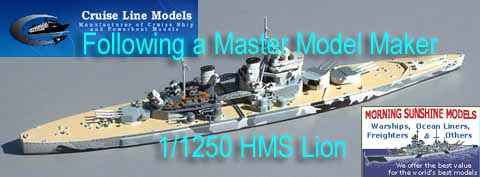
By George Elder and Bruce Gordon

|
|
||||
| Painting | ||||
| Painting involves important decisions, and Dave Moseley
is busily making them for the nearly completed Lion. We got slowed down
a bit because it was decided to use a photoetch crane, which is not quite
done yet. Using PE parts on 1/1250 scale models is very problematic in
terms of production time and cost, and thus this approach is a bit of an
experiment. But everything else is fairly much complete, although a few
things still need to be tweaked. And now we move to the next phase -- painting.
Please note that paint categories can be ambiguous. For example, some folks
note that there are Acrylic Lacquer Paints, so I am sure there will be
plenty of room for squabbling – not that any discord is needed.
Of course, most model makers lay down a sprayed-on primer or base-coat, upon which all else placed. Dave’s paint of choice is a very fine “cellulite” concoction – which is something most of us would recognize as a type of lacquer with cellulite grains that are as fine as talc. Traditional lacquers are difficult to work with because the agents they use are very volatile – and toxic. Moreover, if they are applied too thickly they can dissolve plastic, so this is a tricky material to use. However, the pigments many lacquers contain are very fine indeed and often produce an exceptional finish that doesn’t bury fine details. Moreover, lacquers can be easily tinted, and thus numerous colors are possible. Dave has used the material for years, and has it down to a science. Shown is a view of the stern area of the Lion after it has received a coat of Dave’s preferred paint, which is a light shade of gray that matches the color chips Dave has set aside for the Lion. As one can see, the paint coat has not obscured the fine etching on the hatch covers. Please see Snyder & Short for some great color info on all types of warships. |
 |
|||
| The primer coat can serve as the base coat if the correct
material is used and enough time is allowed for the paint to cure. In 1/1250
scale modeling it is very risky to use both a primer coat as well as a
base coat because of thickness concerns, and most manufacturers use the
base coat as a surface for other paints. Thus, the better the base/primer
coat holds and reacts to other paints -- the easier it will be to apply
additional colors. Moreover, if the base coat is allowed to dry, most types
of paints can be applied over it -- although some paints hate each other
(e.g., lacquers and enamels). Shown here is the overall model as sprayed.
(The model shown is fairly close to the production version, but Dave says
the production version will be much better painted. He was not pleased
with this paint job -- but it seems fine to me.)
The pressure used will vary, depending on the type of paint that is
being employed. Dave does trial-and-error pre-testing, depending on the
mixture, but pressure usually runs about 92.5 psi or abour 6 barrs, which
is a very high indeed.
|
||||
| Details | ||||
| Dave didn't show each step of the painting process, but
the way he has constructed the model allows for a very fine level of painting.
He began by doing the deck, and then painted the sub-assemblies before
they were attached. The life boats on this model are -- well, better than
good -- and each one was painted separately. The great debate we are having
here involves the types of paint to use. We may apply a somewhat lighter
main deck color. I believe this is an enamel. Acrylics were used for the
dark gray upper deck surfaces, but Dave is far from pleased with them.
Humbrol paints are being sought to replace the acrylic paints used here.
Shown is the overall finish, with due notes that some minor changes may
be made in the 5.25" and that the crane is not fitted.
Due to the subassembly technique used to make this model, every deck can be painted, which is a very nice touch -- and this is how the basic models will all be done. The camouflage models will be far more elaborate. As noted, Dave absolutely hates this dark gray acrylic -- in every possibly way. He thinks it is too thick, doesn't cover well, etc. Still, he seems to have produced a good result with it. Part of producing a model is making sure it is affordable, so that is always in the background with regard to what we can do. In addition to the PE crane, Dave is even going to supply a plane with PE tail wings -- but here again -- cost is a concern! Lastly, we will be making these in kit form, but only after we have recovered our costs from sales of the completed items. And -- we will be offering parts. So lots of good news for you scratch builders. But we're still a little ways out with regard to getting this model into production. |
||||
 |
||||
 |
||||
|
|
||||